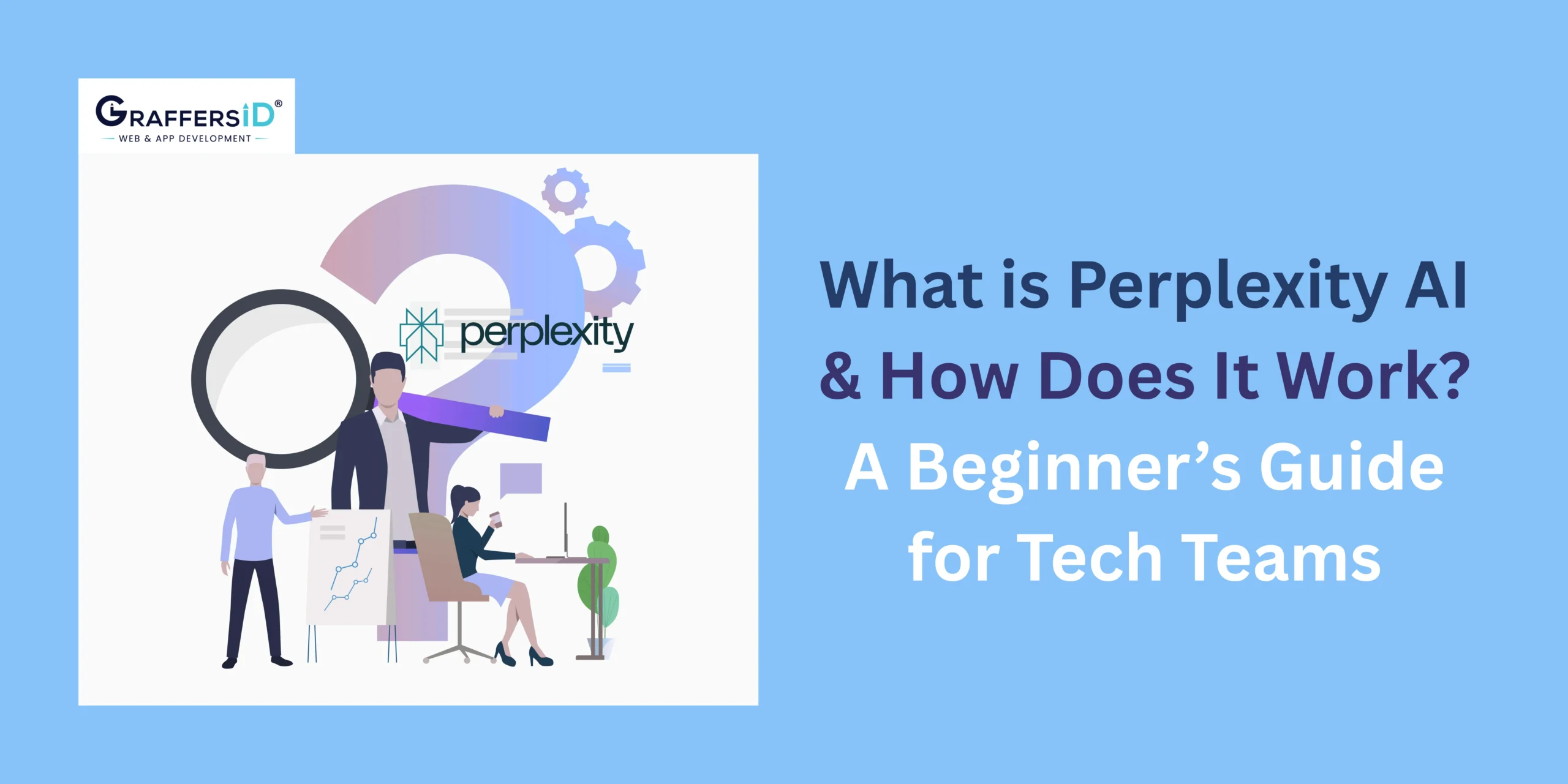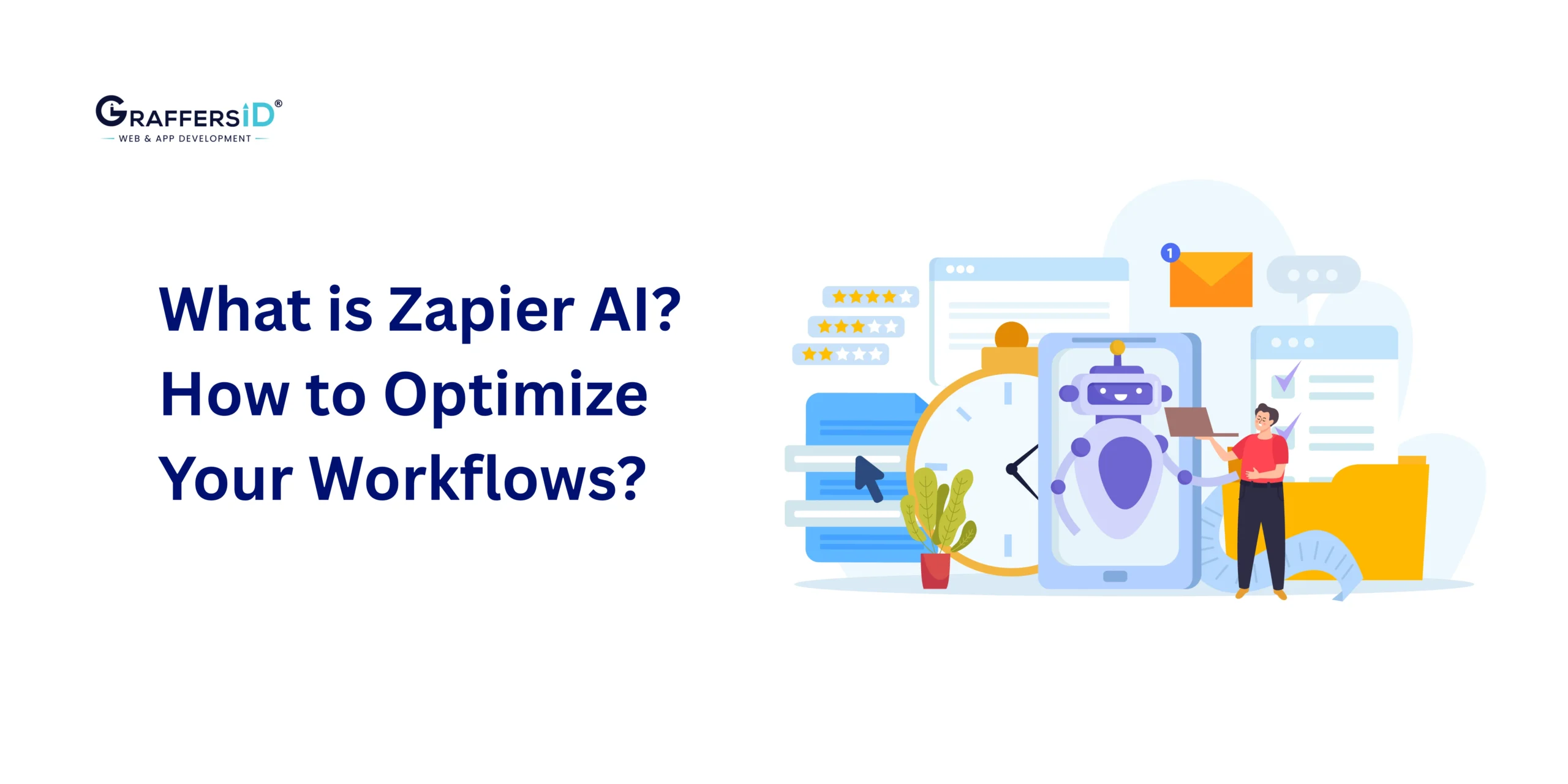Online search engines have undergone a major shift in recent years. While Google has dominated the market for many years, a new wave of AI-powered search engines is changing the way we gather and consume information. Perplexity AI, an advanced search assistant that combines real-time data extraction with conversational skills, is at the forefront of this trend in 2025.
In contrast to traditional search engines offering a list of links, Perplexity AI provides accurate, conversational responses backed up by real-time web sources. It allows users, especially tech teams, developers, and founders, to get precise and relevant responses without having to search through various sources.
In this comprehensive guide, we’ll discuss what Perplexity AI is, how it works, and why it has become an essential component for the modern tech stack.
What Is Perplexity AI?
Perplexity AI is an AI-powered search engine that provides real-time, conversational responses backed up by live web references. Perplexity, developed by former OpenAI researcher Aravind Srinivas, brings together advanced retrieval techniques with the strength of large language models (LLMs) like GPT-4 Turbo, Claude, and Mixtral.
Key highlights:
- Founded in 2022 and financed by venture funding from top companies like Nvidia and NEA.
- It captures new data from the internet in real-time instead of relying just on pre-trained data, unlike ChatGPT.
- Well-known for its Copilot mode, which offers contextual assistance to users by scanning live web pages.
Perplexity is a combination of both Google and ChatGPT, aiming at knowledge-intensive users who require quick, accurate, and cited answers.
Key Features of Perplexity AI
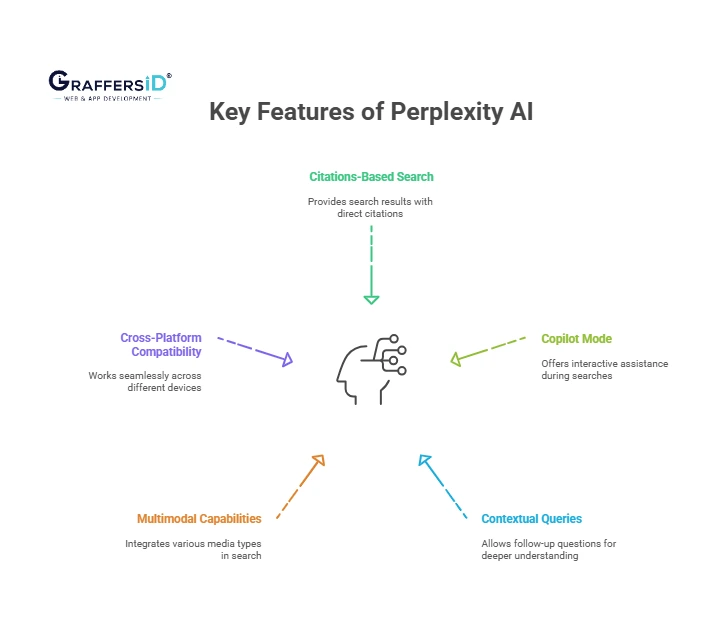
1. Citations-Based AI Search
Each response is backed by a set of credible, clickable web references. This promotes openness and enables users to immediately verify the information.
2. Copilot Mode
This advanced feature allows Perplexity to actively scan to understand the content of an article or web page you are currently browsing. Think of it as a smart assistant that reads pages for you and offers summaries, insights, and contextual replies.
3. Follow-Up Contextual Queries
Perplexity retains context from previous prompts, allowing you to conduct in-depth research or investigations in a natural flow.
4. Multimodal Capabilities
Although still in evolution, Perplexity is expanding its ability to handle image inputs, document uploads, and more.
5. Cross-Platform Compatibility
Accessible via:
- Web Interface
- iOS and Android apps
- Browser Extensions (especially useful in Copilot mode)
Read More: How are AI-Powered Tools Transforming the Tech Industry?
How Perplexity AI Works?
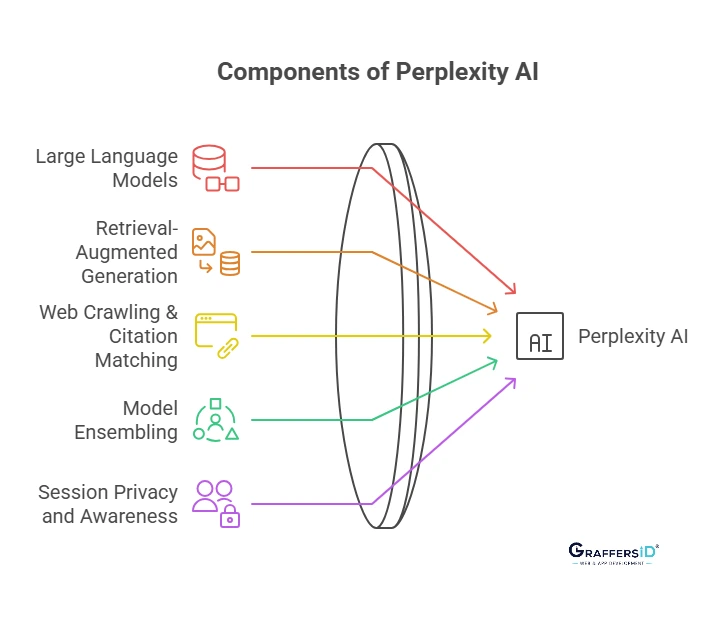
1. Large Language Models (LLMs)
Modern LLMs like GPT-4 Turbo, Claude, and Mixtral are used by Perplexity, depending on the level of complexity and domain of the query. With the help of these models, the AI can interpret user intent, gather relevant data, and generate human-like responses.
2. Retrieval-Augmented Generation (RAG)
The core of Perplexity’s functionality is RAG. It first gathers new, reliable sources from the internet and then feeds that information into an LLM to provide a response. This guarantees that the data is correct and up to date.
3. Web Crawling & Citation Matching
Perplexity has a built-in crawler that scans web content, indexes sources, and fetches the most relevant links. These links are then cited in the AI’s output for transparency.
4. Model Ensembling
Perplexity can select from a variety of models rather than depending on a single LLM to obtain the most accurate outcome. This enhances precision in a variety of fields, including technical, medical, legal, etc.
5. Session Privacy and Awareness
Perplexity remembers the context of your current session even if you are not logged in. In multi-part questions, it guarantees a smooth flow while protecting user privacy.
Use Cases of Perplexity AI for Tech Teams
The following are comprehensive use cases that are specifically meant to show developers how to use Perplexity AI at different phases of the software development lifecycle:
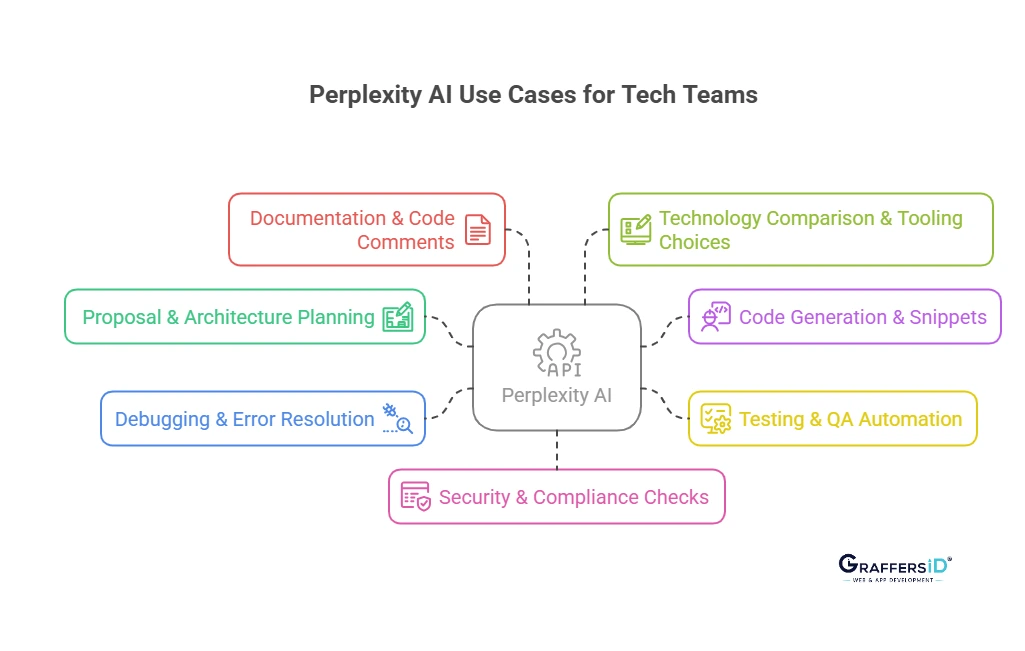
1. Proposal & Architecture Planning
When developers are involved in RFP responses or early-stage project planning, Perplexity helps streamline the research-heavy phase. Use it for:
- Quick search for architecture references, case studies, or popular frameworks used in similar solutions.
- Assess what software or methods competitors are using with current source links.
- Get side-by-side comparisons (e.g., Express vs Node for backend scalability) with benchmark data and citations.
2. Code Generation & Snippets
Perplexity can generate reliable and context-aware code snippets using real-time data and documentation. Use it for:
- Writing utility functions or boilerplate code in Python or JavaScript.
- Searching for examples of a particular syntax in open-source documents or repositories.
- Generating data models, CLI tools, or sample API routes based on best practices.
3. Testing & QA Automation
Developers can automate their test strategy research and code testing patterns using Perplexity. Use it for:
- Generating unit test cases with frameworks.
- Finding edge case examples and common bug patterns.
- Exploring CI/CD testing workflows and integration setups.
4. Debugging & Error Resolution
One of the most time-saving use cases of Perplexity, it helps troubleshoot common and unusual issues more quickly than finding them through forums. Use it for:
- Explaining cryptic errors with possible causes and solutions.
- Finding GitHub or Stack Overflow forums that directly suggest bug fixes.
- Offering real-time solutions for build failures or deployment issues.
5. Documentation & Code Comments
Instead of taking hours to write docstrings or README files, allow Perplexity to speed it up with citation-backed suggestions. Use it for:
- Drafting inline documentation for custom classes and functions.
- Generating professional README.md templates.
- Searching for industry-standard commenting practices for open-source readiness.
6. Technology Comparison & Tooling Choices
Confused between two libraries or cloud platforms? Perplexity makes decision-making easy with updated, cited comparisons. Use it for:
- Comparing logging tools.
- Deciding between different real-time databases.
- Understanding licensing, scalability, and performance differences with web citations.
7. Security & Compliance Checks
While developing enterprise or user-sensitive applications, security is crucial. Perplexity can help speed up secure coding practices. Use it for:
- Identifying vulnerabilities in your tech stack.
- Implementing OAuth2.0 or JWT securely.
- Researching compliance requirements such as HIPAA, GDPR, etc.
How Perplexity Differs from Other AI Models
| Feature | Perplexity AI | OpenAI GPT | Claude (Anthropic) | Meta’s LLaMA |
| Primary Use Case | AI-powered search engine | General-purpose assistant | Safe, helpful conversations | Research & open-source base |
| Live Web Access | ✅ Yes (via RAG + crawling) | ❌ (Free), ✅ (Plus w/ Bing) | ❌ (Static knowledge base) | ❌ (Requires custom RAG) |
| Model Switching | ✅ Yes (uses GPT, Claude, etc.) | ❌ Limited to chosen model | ❌ Claude only | ❌ Self-deploy required |
| Citation Support | ✅ Inline citations | ❌ (Unless prompted) | ❌ Limited | ❌ Not native |
| Custom App Integration | Planned/API in development | Via API | With limitations | ✅ Fully customizable |
| Safety Alignment | ✅ Curated + diverse sources | ✅ Moderate | ✅ High safety focus | ❌ Open research |
Perplexity stands out as an effective resource for reliable, real-time research workflows by offering live internet searching, inline citations, and multi-model access. Unlike GPT, Claude, or LLaMA, which often rely on custom integrations or static training data, Perplexity is ready to use and optimized for quick decision-making in dynamic settings.
Read More: ChatGPT vs. DeepSeek vs. Google Gemini: Which AI Model is Best for Developers?
Limitations of Perplexity AI
Even with its advantages, Perplexity AI has some limitations. Tech teams considering adopting it should be aware of the following limitations:
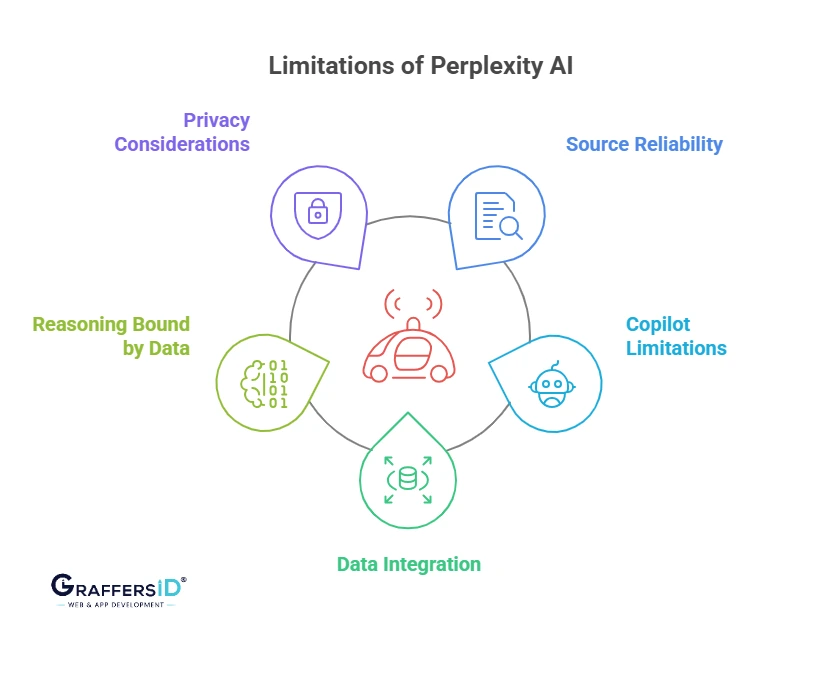
1. Source Reliability and Relevance
The credibility of the sources cited by Perplexity can vary. It may occasionally pull content from low-authority sites or outdated pages. This demands careful human validation, especially for technical or business-critical decisions.
2. Copilot Limitations
Copilot is helpful, but it is still developing. It may misread data or overlook important insights in complicated online applications or encrypted content.
3. No Custom Tuning or Internal Data Integration
Unlike enterprise-level solutions, Perplexity does not yet support internal database integration or fine-tuning based on your proprietary documents. This limits its role in sensitive workflows.
4. Reasoning Bound by Source Data
It is limited by what is available on the internet in terms of analysis and hypothesis. Without comprehensive external data, its answers could be general, vague, or even misleading.
5. Privacy Considerations
Though it offers anonymous sessions, users must avoid sharing confidential or proprietary data, as there are no robust guarantees on data handling or retention policies.
How to Set Up & Integrate Perplexity?
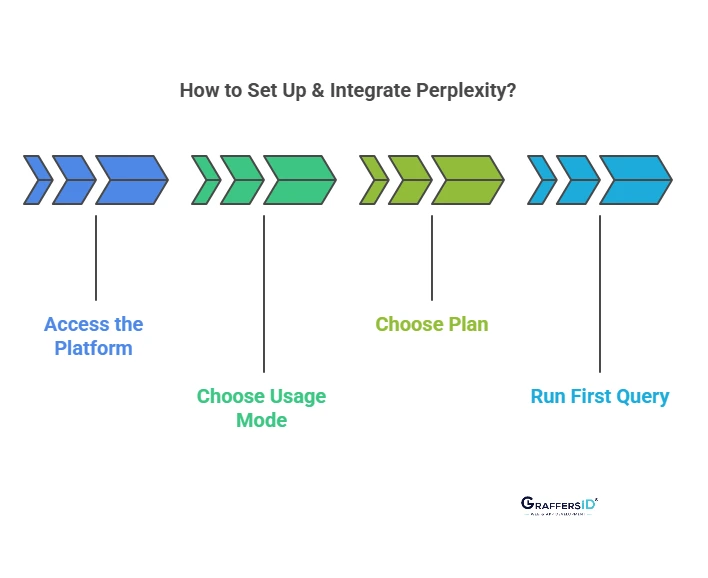
Step 1: Access the Platform
- Go to: https://www.perplexity.ai
- No sign-up required: You can immediately start searching without creating an account for basic use.
- To use Perplexity more efficiently across devices and platforms, you can install Chrome/Firefox extensions to access Copilot features directly. Or download the app on iOS and Android.
Step 2: Choose Your Usage Mode
- Default Search Mode: Type a question or topic into the search bar. Perplexity will return a conversational answer along with cited sources.
- Copilot Mode: Click on the Copilot icon or install the browser extension. This mode helps you explore live web pages or assists with deep research tasks.
Step 3: Choose the Right Plan (Free vs. Pro):
- Free Plan: Ideal for exploring the tool’s core capabilities. You can run basic queries, access citation-based answers, and try out Copilot on a limited basis. Perfect for individual developers or small teams looking to test its value.
- Pro Plan ($20/month): Allows extended context history, unlimited Copilot usage, and access to advanced models like GPT-4 Turbo and Claude. This is ideal for teams that perform extensive research, competitive analysis, or create content-rich technical documentation on a regular basis.
Step 4: Run Your First Query
Try prompts like:
- “Best frontend frameworks for SaaS apps in 2025”
- “How to integrate Razorpay in Node.js with code example”
- “Productivity tools comparison for remote developer teams”
Each result will include:
- A direct, human-like summary
- Sources you can click on and verify
- Suggested follow-up questions
To get the most value, here are a few tips for crafting effective prompts:
- Be specific and contextual
- Mention your audience or purpose
- Use follow-up questions
- Avoid general questions. Instead, guide the AI with detail.
Conclusion: Is Perplexity Worth It for Tech Teams in 2025?
Perplexity AI creates a link between LLM chat tools and search engines by providing prompt, reliable, and contextual responses. It is a game-changer for tech teams who are balancing content research, debugging, product decisions, and competitive intelligence.
While it might not be able to completely replace tools like Google or ChatGPT, it offers exceptional efficiency for real-time, cited search.
GraffersID can assist founders and startups looking to create AI-powered solutions or models like Perplexity. We offer the top vetted AI developers with expertise in custom web platforms, AI tooling, and LLM integration.
Get in touch with us right now to create your own productivity tool or AI agent.
